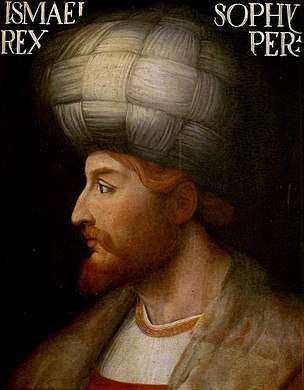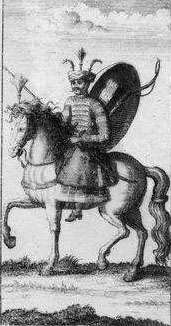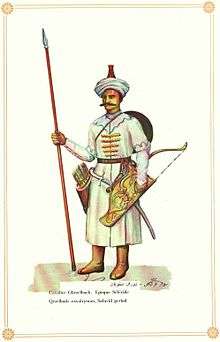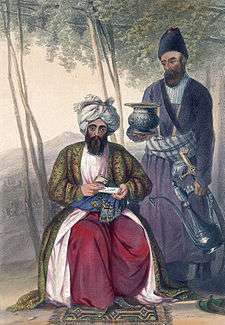Qizilbash
| |||
|---|---|---|---|
| The Fourteen Infallibles | |||
|
|||
| Principles | |||
| Other beliefs | |||
| Practices | |||
| Holy cities | |||
| Groups | |||
|
|
|||
| Scholarship | |||
| Hadith collections | |||
| Related topics | |||
| Related portals | |||
|
|||
Qizilbash or Kizilbash, (Turkish: Kızılbaş - Red Head, sometimes also Qezelbash or Qazilbash, Persian: قزلباش) is the label given to a wide variety of Shi'i militant groups that flourished in Azerbaijan (historic Azerbaijan, also known as Iranian Azerbaijan),[1][2] Anatolia and Kurdistan from the late 15th century onwards, some of which contributed to the foundation of the Safavid dynasty of Iran.[3][4]
Etymology
The word Qizilbash is Ottoman Turkish (قزلباش; modern Turkish Kızılbaş / Turkish pronunciation: [kɯ.zɯɫ.baʃ]), meaning "Crimson/Red Head[ed]". The expression is derived from their distinctive twelve-gored crimson headwear (tāj or tark in Persian; sometimes specifically titled "Haydar's Crown" تاج حیدر / Tāj-e Ḥaydar),[5] indicating their adherence to the Twelve Imams and to Shaykh Haydar, the spiritual leader (sheikh) of the Safaviyya movement in accordance with the Twelver Shi'i doctrine of the Imamate.[6] The name was originally a pejorative label given to them by their Sunni Ottoman foes, but soon it was adopted as a provocative mark of pride.
Origins
The origin of the Qizilbash can be dated from the 15th century onward, when the spiritual grandmaster of the movement, Shaykh Haydar (the head of the Safaviyya Sufi order), organized his followers into militant troops.
Connections between the Qizilbash and other religious groups and secret societies, such as the Mazdaki movement in the Sasanian Empire, or its more radical offspring, the Persian Khurramites, have been suggested. Like the Qizilbash, the latter were an early Shi'i ghulat group[3] and dressed in red, for which they were termed "the red-haired ones" (Arabic: محمرة muḥammirah) by medieval sources.[7] In this context, Turkish scholar Abdülbaki Gölpinarli sees the Qizilbash as "spiritual descendants of the Khurramites".[3]
Organization
The Qizilbash were a coalition of many different tribes of predominantly (but not exclusively) Turkic-speaking background united in their adherence to Safavi Shia Islam.
As murids of the Safavi sheikhs (pirs), the Qizilbash owed implicit obedience to their leader in his capacity as their murshid-e kāmil "supreme spiritual director" and, after the establishment of the kingdom, as their padishah, changing the purely religious pir – murid relationship into a political one. As a consequence, any act of disobedience of the Qizilbash Sufis against the order of the spiritual grandmaster (Persian: nāsufigari "improper conduct of a Sufi") became "an act of treason against the king and a crime against the state", as was the case in 1614 when Padishah Abbas the Great put some followers to death.[8]
Beliefs
| |
|---|
 |
|
|
The Qizilbash adhered to heterodox Shi’i doctrines encouraged by the early Safavi sheikhs Haydar and his son Ismail I. They regarded their rulers as divine figures, and so were classified as ghulat "extremists" by orthodox Twelvers.[9]
When Tabriz was taken, there was not a single book on Twelverism among the Qizilbash leaders. The book of the well known Iraqi scholar al-Hilli (1250–1325) was procured in the town library to provide religious guidance to the state.[10] The imported Shi'i ulama did not participate in the formation of Safavid religious policies during the early formation of the state. However, ghulat doctrines were later forsaken and Arab Twelver ulama from Lebanon, Iraq, and Bahrain were imported in increasing numbers to bolster orthodox Twelver practice and belief.
Qizilbash aquida in Anatolia
In Turkey, Shia Muslim people belong to the Ja'fari jurisprudence Madhhab, which tracks back to the sixth Shia Imam Ja'far al-Sadiq (also known as Jafar-i Sadiq), are called the Ja'faris, who belong to Twelver Shia. Although the Qizilbash Turks are considered a part of Twelver Shia Islam, their belief is different from the Ja'fari jurisprudence in conviction.
- The Qizilbash have a unique and complex conviction tracing back to Kaysanites Shia and Khurramites which are considered as ghulat Shia. According to Turkish scholar Abdülbaki Gölpinarli, the Qizilbash ("Red-Heads") of the 16th century - a religious and political movement in Azerbaijan (historic Azerbaijan, also known as Iranian Azerbaijan) that helped to establish the Safavid dynasty - were "spiritual descendants of the Khurramites".[11]
- Among the members of the Qizilbash tariqah who are considered as a sub-sect of the Alevis, two figures firstly Abu Muslim Khorasani who assisted the Abbasid Caliphate to beat Umayyad Caliphate, but later eliminated and murdered by Caliph Al-Mansur, and secondly Babak Khorramdin who incited a rebellion against the Abbasid Caliphate and consequently was killed by Caliph al-Mu'tasim are highly respected. This belief provides strong clues about their Kaysanites Shia and Khurramites origins. In addition, the Safaviyya leader Ismail I is a highly regarded individual in the belief of Qizilbash associating them with the Imamah doctrine of the Twelver Shia Islam.
- Their aqidah (theological conviction) is based upon a syncretic fiqh system called Batiniyya[12] which incorporates some Qarmatian thoughts, originally introduced by Abu’l-Khāttāb Muhammad ibn Abu Zaynab al-Asadī,[13][14] and later developed by Maymun al-Qāddāh and his son ʿAbd Allāh ibn Maymun,[15] and Mu'tazila with a strong belief in The Twelve Imams.
- Not all of the members believe that the fasting in Ramadan is obligatory although some Alevi Turks performs their fasting duties partially in Ramadan.
- Some beliefs of Shamanism still are common amongst the Qizilbash Alevi-Turkish people in villages.
- On the other hand, the members of Bektashi Order have a conviction of "Batiniyya Isma'ilism"[12] and "Hurufism" with a strong belief in the Twelve Imams.
- In conclusion, Qizilbash-Alevis are not a part of Ja'fari jurisprudence fiqh, even though they can be considered as members of different tariqa of Shia Islam all looks like sub-classes of Twelver. Their conviction includes Batiniyya-Hurufism and "Sevener-Qarmatians-Ismailism" sentiments.[12][16]
- They all may be considered as special groups not following the Ja'fari jurisprudence, like Alawites who are in the class of ghulat Twelver Shia Islam, but a special Batiniyya belief somewhat similar to Isma'ilism in their conviction.
"Turk & Tājīk"

Among the Qizilbash, Turcoman tribes from Eastern Anatolia and Azerbaijan (historic Azerbaijan, also known as Iranian Azerbaijan) who had helped Ismail I defeat the Aq Qoyunlu tribe were by far the most important in both number and influence and the name Qizilbash is usually applied exclusively to them.[17] Some of these greater Turcoman tribes were subdivided into as many as eight or nine clans, including:
- Ustādjlu (Their Orgings reaches to the Begdili)
- Rūmlu
- Shāmlu (the most powerful clan during the reign of Shah Ismail I.)
- Dulkadir (Arabic: Dhu 'l-Kadar)
- Afshār
- Qājār
- Takkalu
Other tribes – such as the Turkman, Bahārlu, Qaramānlu, Warsāk, and Bayāt – were occasionally listed among these "seven great uymaqs". Today, the remnants of the Qizilbash confederacy are found among the Afshar, the Qashqai, Turkmen, Shahsevan, and others.[18]
Some of these names consist of a place-name with addition of the Turkish suffix -lu, such as Shāmlu or Bahārlu. Other names are those of old Oghuz tribes such as the Afshār, Dulghadir, or Bayāt, as mentioned by the medieval Uyghur historian Mahmud al-Kashgari.
The non-Turkic Iranian tribes among the Qizilbash were called Tājīks by the Turcomans and included:[17][19]
The rivalry between the Turkic clans and Persian nobles was a major problem in the Safavid kingdom. As V. Minorsky put it, friction between these two groups was inevitable, because the Turcomans "were no party to the national Persian tradition". Shah Ismail tried to solve the problem by appointing Persian wakils as commanders of Qizilbash tribes. The Turcomans considered this an insult and brought about the death of 3 of the 5 Persians appointed to this office – an act that later inspired the deprivation of the Turcomans by Shah Abbas I.[20]
History

The Beginnings
In the 15th century, Ardabil was the center of an organization designed to keep the Safavi leadership in close touch with its murids in Azerbaijan, Iraq, Eastern Anatolia and elsewhere. The organization was controlled through the office of khalīfāt al-khulafā'ī who appointed representatives (khalīfa) in regions where Safavi propaganda was active. The khalīfa, in turn, had subordinates termed pira. The Safavi presence in eastern Anatolia posed a serious threat to the Ottoman Empire because they encouraged the Shi'i population of Asia Minor to revolt against the sultan.
In 1499, Ismail, the young leader of the Safavi order, left Lahijan for Ardabil to make a bid for power. By the summer of 1500, about 7,000 supporters from the local Turcoman tribes of Asia Minor (Anatolia), Syria, and the Caucasus – collectively called "Qizilbash" by their enemies – rallied to his support in Erzincan.[21] Leading his troops on a punitive campaign against the Shīrvanshāh (ruler of Shirvan), he sought revenge for the death of his father and his grandfather in Shīrvan. After defeating the Shīrvanshāh Farrukh Yassar and incorporating his kingdom, he moved south into Azarbaijan, where his 7,000 Qizilbash warriors defeated a force of 30,000 Aq Qoyunlu under Alwand Mirzā[22] and conquered Tabriz. This was the beginning of the Safavid state.
By 1510, Ismail and his Qizilbash had conquered the whole of Iran and the Republic of Azerbaijan,[23] southern Dagestan (with its important city of Derbent), Mesopotamia, Armenia, Khorasan, Eastern Anatolia, and had made the Georgian kingdoms of Kartli and Kakheti his vassals.[24][25] Many of these areas were priorly under the control of the Ak Koyunlu.
In 1510 Shah Ismail sent a large force of the Qizilbash to Transoxiania to fight the Uzbeks. The Qizilbash defeated the Uzbeks and secured Samarkand at the Battle of Marv. However, in 1512, an entire Qizilbash army was annihilated by the Uzbeks after Turcoman Qizilbash had mutinied against their Persian wakil and commander Najm-e Thani at the Battle of Ghazdewan.[26] This defeat put an end to Safavid expansion and influence in Transoxania and left the northeastern frontiers of the kingdom vulnerable to nomad invasions, until some decades later.
The Battle of Chaldiran
Meanwhile, the Safavid da'wa (propaganda) continued in Ottoman areas – with great success. Even more alarming for the Ottomans was the successful conversion of Turcoman tribes in Eastern Anatolia, and the recruitment of these well experienced and feared fighters into the growing Safavid army. In order to stop the Safavid propaganda, Sultan Bayezid II deported large numbers of the Shi'i population of Asia Minor to Morea. However, in 1507, Shah Ismail and the Qizilbash overran large areas of Kurdistan, defeating regional Ottoman forces. Only two years later in Central Asia, the Qizilbash defeated the Uzbeks at Merv, killing their leader Muhammad Shaybani and destroying his dynasty. His head was sent to the Ottoman sultan as a warning.

In 1511, a pro-Safavid revolt known as the Shahkulu Uprising broke out in Teke. An imperial army that was sent to suppress it, was defeated. Shah Ismail sought to turn the chaos within the Ottoman Empire to his advantage and moved up his borders even more westwards in Asia Minor. The Qizilbash defeated a large Ottoman army under Sinan Pasha. Shocked by this heavy defeat, Sultan Selim I (the new ruler of the Empire) decided to invade Persia with a force of 200,000 Ottomans and face the Qizilbash on their own soil. In addition, he ordered the persecution of [Alevis[27][28] and the massacre its adherents in the Ottoman Empire.[29]
On the 20 August 1514 (1st Rajab 920 A.H.), the two armies met at Chaldiran in northwestern Iran. The Ottomans -equipped with both firearms and cannon- were reported to outnumber the Qizilbash as much as three to one. The Qizilbash were badly defeated;[30] casualties included many high-ranking Qizilbash amirs as well as three influential ulamā.
The defeat destroyed Shah Ismail's belief in his own invincibility and divine status. It also fundamentally altered the relationship between the murshid-e kāmil and his murids.
The deprivation of the Turcomans
Ismail I tried to reduce the power of the Turcomans by appointing Iranians to the vakil office. However, the Turcomans did not like having an Iranian to the most powerful office of the Safavid Empire, and kept murdering many Iranians who were appointed to that office.[31] After the death of Ismail, the Turkomans managed to seize power from the Iranians, they were however, defeated by Tahmasp I, the son of Ismail.
For almost ten years after the Battle of Chaldiran, rival Qizilbash factions fought for control of the kingdom. In 1524, 10-year-old Shah Tahmasp I, the governor of Herat, succeeded his father Ismail. He was the ward of the powerful Qizilbash amir Ali Beg Rūmlū (titled "Div Soltān") who was the de facto ruler of the Safavid kingdom.[32] However, Tahmasp managed to reassert his authority over the state and over the Qizilbash.
During the reign of Shah Tahmasp, the Qizilbash fought a series of wars on two fronts and – with the poor resources available to them – successfully defended their kingdom against the Uzbeks in the east, and against the arch rivals of the Safavids - the Ottomans - in the west.[33] With the Peace of Amasya (1555), peace between Safavids and Ottomans remained for the rest of Tahmasp's reign.[34] During Tahmasp' reign, he carried out multiple invasions in the Caucasus which had been incorporated in the Safavid empire since Shah Ismail I and for many centuries afterwards, and started with the trend of deporting and moving hundreds of thousands of Circassians, Georgians, and Armenians to Iran's heartlands. Initially only solely put in the royal harems, royal guards, and several other specific posts of the Empire, Tahmasp believed he could eventually reduce the power of the Qizilbash, by creating and fully integrating a new layer in Iranian society with these Caucasian elements and who would question the power and hegemony of the tribal Qizilbash. This included the formation of a military slave system,[35] similar to that of the neighboring Ottoman Empire - the janissaries.[36] Tahmasp's successors, and most importantly Shah Abbas I (r. 1588-1629), would significantly expand this policy, when during the reign of Abbas I alone some 200,000 Georgians, 300,000 Armenians and many tens of thousands of Circassians were relocated to Irans heartlands.[37][38][39][40][41] By this creation of a so-called "third layer" or "third force" in Iranian society composed of ethnic Caucasians, and the complete systematic disorganisation of the Qizilbash by his personal orders, Abbas I eventually fully succeeded in replacing the power of the Qizilbash, with that of the Caucasian ghulams. These new Caucasian elements (the so-called ghilman / غِلْمَان / "servants"), almost always after conversion to Shi'ism depending on given function would be, unlike the Qizilbash, fully loyal only to the Shah. This system of mass usage of Caucasian subjects remained to exist until the fall of the Qajar Dynasty.
Inter-tribal rivalry of the Turcomans, the attempt of Persian nobles to end the Turcoman dominance, and constant succession conflicts went on for another 10 years after Tahmasp's death. This heavily weakened the Safavid state and made the kingdom vulnerable to external enemies: the Ottomans attacked in the west, whereas the Uzbeks attacked the east.

In 1588, Shah Abbas I came to power. He appointed the Governor of Herat and his former guardian and tutor, Alī Quli Khān Shāmlū (also known as Hājī Alī Qizilbāsh Mazandarānī) the chief of all the armed forces. Later on, events of the past, including the role of the Turcomans in the succession struggles after the death of his father, and the counterbalancing influence of traditional Ithnāʻashari Shia Sayeds, made him determined to end the dominance of the untrustworthy Turcoman chiefs in Persia which Tahmasp had already started decades before him. In order to weaken the Turcomans – the important militant elite of the Safavid kingdom – Shah Abbas further raised a standing army, personal guard, Queen-Mothers, Harems and full civil administration from the ranks of these ghilman who were usually ethnic Circassians, Georgians, and Armenians, both men and women, whom he and his predeseccors had taken captive en masse during their wars in the Caucasus, and would systematically replace the Qizilbash from their functions with converted Circassians and Georgians. The new army and civil administration would be fully loyal to the king personally and not to the clan-chiefs anymore.[22]
The reorganisation of the army also ended the independent rule of Turcoman chiefs in the Safavid provinces, and instead centralized the administration of those provinces.
Ghulams were appointed to high positions within the royal household, and by the end of Shah Abbas' reign, one-fifth of the high-ranking amirs were ghulams.[17] By 1598 already an ethnic Georgian from Safavid-ruled Georgia, well known by his adopted Muslim name after conversion, Allahverdi Khan, had risen to the position of commander-in-chief of all Safavid armed forces.[42] and by that became one of the most powerful men in the empire. The offices of wakil and amir al-umarā fell in disuse and were replaced by the office of a Sipahsālār (Persian: سپهسالار, master of the army), commander-in-chief of all armed forces – Turcoman and Non-Turcoman – and usually held by a Persian (Tādjik) noble.
The Turcoman Qizilbash nevertheless remained an important part of the Safavid executive apparatus, even though ethnic Caucasians came to largely replace them. For example, even in the 1690s, when ethnic Georgians formed the mainstay of the Safavid military, the Qizilbash still played a significant role in the army.[43] The Afshār and Qājār rulers of Persia who succeeded the Safavids, stemmed from a Qizilbash background. Many other Qizilbash – Turcoman and Non-Turcoman – were settled in far eastern cities such as Kabul and Kandahar during the conquests of Nadir Shah, and remained there as consultants to the new Afghan crown after the Shah's death. Others joined the Mughal emperors of India and became one of the most influential groups of the Mughal court until the British conquest of India.
Qizilbash in the Mughal Empire
The first Mughal Emperor Babur is known to have attained battalions of elite Qizilbash during the Battle of Ghazdewan, they then served during the Battle of Panipat (1526) and particularly during the Battle of Khanwa where the Mughal Empire won a decisive victory against armed Rajput's led by Rana Sanga.
In the year 1556, Qizilbash troopers are known to have served victoriously under the command of the teenage Mughal Emperor Akbar during the Second Battle of Panipat against armed Rajput's led by Hemu.
Later onward's Ahmad Shah Durrani also sought the assistance of the Qizilbash during the Third Battle of Panipat against the Maratha Confederacy, once again those Qizilbash were conscripted by the Mughal Grand Vizier, Shuja-ud-Daula in service of the Mughal Emperor Shah Alam II.
Legacy
Afghanistan

Qizilbash in Afghanistan live in urban areas, such as Kabul, Herat or Mazari Sharif, as well as in certain villages in Hazarajat. They are descendants of the troops left behind by Nadir Shah during his "Indian campaign" in 1738.[44][45] Afghanistan's Qizilbash held important posts in government offices in the past, and today engage in trade or are craftsmen. Since the creation of Afghanistan, they constitute an important and politically influential element of society. Estimates of their population vary from 60,000 to 200,000.[46][47] They are Persian-speaking Shi'i Muslims.
Sir Mountstuart Elphinstone described the Qizilbash of Kabul in the beginning of the 19th century as "a colony of Turks," who spoke "Persian, and among themselves Turkish."[48] Described as learned, affluent, and influential, they appear to have abandoned their native Turkish language in favour of Persian, and became "in fact Persianized Turks".[49] Lady Florentia Sale (wife of Sir Robert Henry Sale) and Vincent Eyre – both companions of Sir Mountstuart Elphinstone – described the Qizilbash of Afghanistan also as "Persians, of Persian descent".[50][51]
The influence of the Qizilbash in the government created resentment among the ruling Pashtun clans, especially after the Qizilbash openly allied themselves with the British during the First Anglo-Afghan War (1839–1842). During Abdur Rahman Khan's massacre of the Shi'i minorities in Afghanistan, the Qizilbash were declared "enemies of the state" and were persecuted and hunted by the government and by the Sunni majority.[52]
Syria/Lebanon
Between the late seventeenth century and 1822 the term “Qizilbash” was also used in Ottoman administrative documents to identify Twelver (Imami) Shiites in what is today Lebanon. The Ottomans were aware they had no link to the Anatolian or Iranian Qizilbash, employing the term only as a means to delegitimize them or justify punitive campaigns against them. In the early eighteenth century, a part of northern Lebanon is even described as the “Kızılbaş mukataa” tax district.[53]
Turkey
Some contemporary Alevi and Bektashi leaning religious or ethnic minorities in Anatolia are referred to, pejoratively, as Qizilbash.
| “ | It has been reported that, among the Ottoman Turks, kızılbaş has become something of a derogatory term and can be applied to groups that aren't necessarily associated with the Kazilbash of Central Asia. The Bektaşi in Turkey are often referred to as Kızılbaşi[54] | ” |

See also
References
- ↑ Cornell, Vincent J. (2007). Voices of Islam (Praeger perspectives). Greenwood Publishing Group. p. 225 vol.1. ISBN 0275987329.
- ↑ Parker, Charles H. (2010). Global Interactions in the Early Modern Age, 1400–1800. Cambridge University Press. p. 53. ISBN 1139491415.
- 1 2 3 Roger M. Savory: Kizil-Bash. In Encyclopaedia of Islam, Vol. 5, p. 243-45.
- ↑ Savory, EI2, Vol. 5, p. 243: "Kizilbāsh (T. “Red-head”). [...] In general, it is used loosely to denote a wide variety of extremist Shi'i sects [see Ghulāt], which flourished in [V:243b] Anatolia and Kurdistān from the late 7th/13th century onwards, including such groups as the Alevis (see A. S. Tritton, Islam : belief and practices, London 1951, 83)."
- ↑ Note: Tāj, meaning crown in Persian, is also a term for hats used to delineate one's affiliation to a particular Sufi order.
- ↑ Moojan Momen, "An Introduction to Shi'i Islam", Yale Univ. Press, 1985, ISBN 0-300-03499-7, pp. 101–107.
- ↑ H. Anetshofer/H.T. Karateke, Traktat über die Derwischmützen (ri̇sāle-i̇ Tāciyye) des Müstaqīm-zāde Süleymān Sāʻdeddīn; Brill, 2001; ISBN 90-04-12048-3 (German original)
- ↑ Roger M. Savory, "The office of khalifat al-khulafa under the Safawids", in JOAS, lxxxv, 1965, p. 501
- ↑ Momen, 1985
- ↑ Moojan Momen, "An Introduction to Shi'i Islam", Yale Univ. Press, 1985, ISBN 0-300-03499-7, p. 397
- ↑ Roger M. Savory (ref. Abdülbaki Gölpınarlı), Encyclopaedia of Islam, "Kizil-Bash", Online Edition 2005
- 1 2 3 Halm, H. "Bāṭenīya". Encyclopedia Iranica. Retrieved 4 August 2014.
- ↑ "Abu'l-Ḵaṭṭāb Asadī". Retrieved 15 February 2015.
- ↑ "Ḵaṭṭābiya". Retrieved 15 February 2015.
- ↑ "ʿAbdallāh B. Maymūn Al-Qaddāḥ". Retrieved 15 February 2015.
- ↑ Öztürk, Yaşar Nuri, En-el Hak İsyanı (The Anal Haq Rebellion) – Hallâc-ı Mansûr (Darağacında Miraç - Miraç on Gallows), Vol 1 and 2, Yeni Boyut, 2011.
- 1 2 3 Minorsky, Vladimir (1943) "Tadhkirat al-muluk", London, p. 16-18, p.188
- ↑ Tapper, Richard (2011). "Introduction". Tribe and State in Iran and Afghanistan. London: Routledge. p. 11. ISBN 978-0-415-61056-8.
- ↑ Savory, Roger M. (1965). "The consolidation of Safawid power in Persia". Der Islam: Journal of the History and Culture of the Middle East. 41 (1): 71–94. doi:10.1515/islm.1965.41.1.71.
- ↑ Savory, Roger M. (1964). "The significance of the political murder of Mirza Salman". Islamic Studies: Journal of the Central Institute of Islamic Research. Karachi. 3: 181–191.
- ↑ Faruk Sümer, Safevi Devletinin Kuruluşu ve Gelişmesinde Anadolu Türklerinin Rolü, Türk Tarih Kurumu Yayınları, Ankara, 1992, p. 15. (in Turkish)
- 1 2 Roger M. Savory, Encyclopaedia of Islam, "Safawids", Online Edition, 2005
- ↑ BBC, (Link)
- ↑ "History of Iran: Safavid Empire 1502–1736". Retrieved 16 December 2014.
- ↑ "Edge of Empires: A History of Georgia". Retrieved 15 December 2014.
- ↑ Roger M. Savory, "The significance of the political murder of Mirza Salman", in "Studies on the history of Safawid Iran", xv, pp. 186–187
- ↑ "Turkey's Alevis Outraged by 'Executioner' Name for Bridge". bloomberg.com. Retrieved 2014-12-10.
- ↑ "Alevis protest plans to name third bridge after Ottoman Sultan". todayszaman.com. Retrieved 2014-12-10.
- ↑ H.A.R. Gibb & H. Bowen, "Islamic society and the West", i/2, Oxford, 1957, p. 189
- ↑ M.J. McCaffrey, Encyclopaedia Iranica, "Čālderān", v, pp. 656–8, (Link Archived 29 September 2008 at the Wayback Machine.)
- ↑ Savory, R. (2007). Iran Under the Safavids. Cambridge University Press. p. 43. ISBN 9780521042512. Retrieved 2014-12-10.
- ↑ Roger M. Savory in Encyclopaedia Iranica, "Dīv Soltān", Online Edition, 2005, (Link)
- ↑ Rothman 2015, p. 236.
- ↑ M. Köhbach in Encyclopaedia Iranica, "Peace of Amasya", v, p. 928, Online Edition, (Link)
- ↑ Streusand, p. 148.
- ↑ "Barda and Barda-Dāri v. Military slavery in Islamic Iran". Retrieved 15 April 2014.
- ↑ Blow 2009, p. 66.
- ↑ Aslanian 2011, p. 1.
- ↑ Bournoutian 2002, p. 208.
- ↑ Mikaberidze 2015, pp. 291, 536.
- ↑ Floor & Herzig 2012, p. 479.
- ↑ C. Fleischer, Encyclopaedia Iranica, "Allāhverdi Khān", v, pp. 891–892, Online Edition, 2005, (Link)
- ↑ Matthee, Rudi (2012). Persia in Crisis: Safavid Decline and the Fall of Isfahan. I.B.Tauris. p. 114. ISBN 978-1845117450.
- ↑ 5. The Rise of Afghanistan, page 124 // Afghanistan: A Military History from Alexander the Great to the War Against the Taliban. Author: Stephen Tanner. First published in 2002 by Da Capo Press; (revised edition) reprinted in 2009. Philadelphia: Da Capo Press, 2009, 375 pages.
ISBN 9780306818264
“ The Qizilbash, or "Red Heads," were Turkic warriors-turned-Persian who had arrived in Afghanistan in numbers after Nadir Shah's and other Persian debacles. ” - ↑ The Dictionary. — N. — Nadir Shah Afshar, page 305 – 306. // Historical Dictionary of Afghanistan. Fourth edition. Author: Ludwig W. Adamec. Lanham: Scarecrow Press, 2012, XCV+569 pages.
ISBN 9780810878150
“ Some of Nadir's Qizilbash soldiers settled in Afghanistan where their descendants had successful careers in the army (until the end of Dost Muhammad's rule), government, the trades, and crafts. ” - ↑ Countries and Their Cultures: Qizilbash:..Obtaining accurate population figures for the Qizilbash in Afghanistan and Pakistan is virtually impossible because they claim to be Sunni, Tajik, Farsiwan, or Pashtun, or they identify themselves according to their place of origin in India. Population estimates for Afghanistan range from 30,000 to 200,000, but some suggest the figure is closer to one million. The story is similar in Pakistan. Few influential Qizilbash live in Iran, their original home...
- ↑ Social Structure. — Ethnic Groups, page 104. // Afghanistan: A Country Study. Editors: Richard F. Nyrop, Donald M. Seekins. Baton Rouge: Claitor's Law Books and Publishing Division, 2001, 226 pages.
ISBN 9781579807443
“ In 1996, approximately 40 percent of Afghans were Pashtun, 11.4 of whom are of the Durrani tribal group and 13.8 percent of the Ghilzai group. Tajiks make up the second largest ethnic group with 25.3 percent of the population, followed by Hazaras, 18 percent; Uzbeks, 6.3 percent; Turkmen, 2.5 percent; Qizilbash, 1.0; 6.9 percent other. The usual caveat regarding statistics is particularly appropriate here. ” - ↑ Mountstuart Elphinstone, An Account of the Kingdom of Caubul, pp. 320–321
- ↑ Henry Yule, "Hobson-Jobson", London, 1886, p. 380
- ↑ Lady Sale, "A Journal of the Disasters in Afghanistan 1841–42", London, Murray 1843, p. IX
- ↑ Vincent Eyre, "The Military Operations at Cabul", London, Murray, MDCCCXLIII, p. XXXI.
- ↑ U.S. Library of Congress, "Afghanistan: The society and its environment", index s.v. Qizilbash, (Link)
- ↑ Stefan Winter, “The Kızılbaş of Syria and Ottoman Shiism” in Christine Woodhead, ed., The Ottoman World (London: Routledge, 2012), 171-183.
- ↑ John Winter Crowfoot, "Survivals among the Kappadokian Kizilbash (Bektash)", Journal of the Anthropological Institute of Great Britain and Ireland, 30., 1900, pp. 305–20
Sources
- Yves Bomati and Houchang Nahavandi,Shah Abbas, Emperor of Persia,1587-1629, 2017, ed. Ketab Corporation, Los Angeles, ISBN 978-1595845672, English translation by Azizeh Azodi.
- Aslanian, Sebouh (2011). From the Indian Ocean to the Mediterranean: The Global Trade Networks of Armenian Merchants from New Julfa. California: University of California Press. ISBN 978-0520947573.
- Blow, David (2009). Shah Abbas: The Ruthless King Who Became an Iranian Legend. I.B.Tauris. ISBN 978-0857716767.
- Bournoutian, George (2002). A Concise History of the Armenian People: (from Ancient Times to the Present) (2 ed.). Mazda Publishers. p. 208. ISBN 978-1568591414.
- Floor, Willem; Herzig, Edmund (2012). Iran and the World in the Safavid Age. I.B.Tauris. ISBN 978-1850439301.
- Mikaberidze, Alexander (2015). Historical Dictionary of Georgia (2 ed.). Rowman & Littlefield. ISBN 978-1442241466.
- Rothman, E. Nathalie (2015). Brokering Empire: Trans-Imperial Subjects between Venice and Istanbul. Cornell University Press. ISBN 978-0801463129.